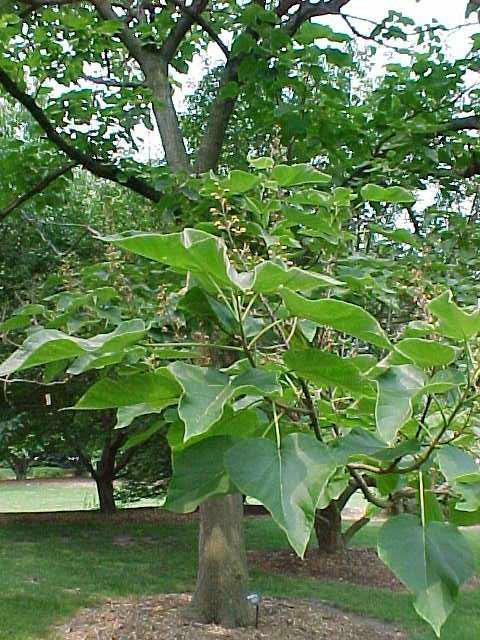Princess tree (Paulownia tomentosa)
Princess tree
Paulownia tomentosa, commonly called royal paulownia, empress tree or princess tree, is native to China. It is a fast-growing, deciduous tree that is primarily grown for its profuse spring bloom of foxglove-like flowers and its large catalpa-like green leaves. It was first introduced into the United States in the mid 1800s, and has since escaped cultivation and naturalized in many areas of the eastern U.S. It is an upright to spreading deciduous tree that typically grows to 40’ tall with a rounded crown. It is noted for its profuse bloom of fragrant, tubular, funnel-shaped, pinkish-lavender flowers (to 2” long) with interior dark purple spotting and creamy yellow striping. Flowers appear in spring in clusters (to 14” long) before the foliage. Flower aroma is reminiscent of vanilla. Flowers are edible and are sometimes added to salads. Flowers are followed by oval, woody, dehiscent seed capsules that emerge sticky green and ripen to brown in fall, at which point they split open releasing abundant winged seeds. Ovate, green leaves (to 5-12” long) are lightly hairy above and densely hairy beneath. No fall color. Paulownia is currently placed in its own family. Wood is commercially valuable in Japan.
Genus name honors Princess Anna Paulowna (1795-186- , daughter of Czar Paul I of Russia.
Specific epithet from Latin means having soft woolly hairs.

Easily grown in average, medium, well-drained soils in full sun. Prefers sandy humusy loams with good drainage. Tolerates a wide range of soils including poor, dry ones, but dislikes unamended heavy clay soils typical of the St. Louis area. Tolerates light shade, but is generally intolerant of shady conditions. Blooms on old wood (buds form in summer for the following spring bloom). Overwintering flower buds are ornamentally attractive, but may be damaged in very cold winters, particularly when temperatures dip below 0 degrees F. Best sited in locations protected from strong winds. Paulownias may be grown as non-flowering foliage plants by administering annual hard dormant season prunings. Tree forms may be pollarded (annually prune branches back to the trunk) and shrub forms may be coppiced (annually prune stems to the ground). Such hard dormant season prunings encourage the development of much larger leaves (up to 24” long) at the expense of the spring flowers. Can also be grown in containers as a foliage plant.
| Hardiness zone | 5 - 8 |
| Sun light | Full sun |
| Water | Dry to medium |
| Maintenance | Medium |
No serious insect or disease problems. Flower buds may be killed by harsh winters.
Beautiful specimen flowering tree for lawns and gardens. Has also been used effectively in poor soils in surface stripmine reclamation areas.
| Common name | Princess tree |
| Botanical name | Paulownia tomentosa |
| Plant type | Tree |
| Family | Paulowniaceae |
| Hardiness zone | 5 - 8 |
| Water | Dry to medium |
| Maintenance | Medium |
| Flower color | Pinkish-lavender |
| Flowering period | April |
| Height | 30 - 40 ft. |
| Width | 30 - 40 ft. |